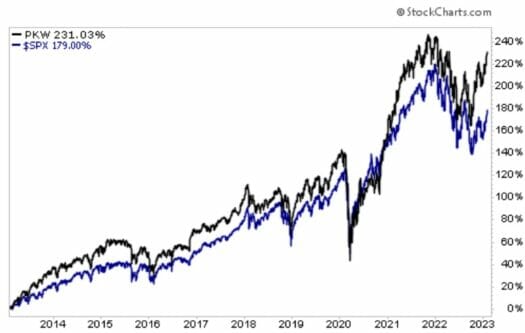4 Time-Tested, Proven Ways To Actually Beat The Market
Investment analysts, advisors, and fund managers spend their entire working lives and billions of dollars on research vowing to “beat the market” (i.e., pick investments that outperform the S&P 500 index) in any given year.
Yet most of them fail. Just look at the track record among mutual fund managers. Just 38% of active fund managers beat their benchmark in 2023. That means most investors would have been better off in a passive index fund.
This discrepancy in performance only gets worse when you expand the period out to five years. Any way you slice it, the results can be summed up in one word: underwhelming.
This isn’t to trash mutual funds (or their managers). There are many high-quality options out there.
But if the so-called experts can’t find winning investments, can we? The answer: Yes!
While the odds may seem daunting, there are ways to beat the market. Some time-tested, researched-backed investing techniques have actually proven to generate consistent returns or even outperform. Here are a few…
4 Ways To Beat The Market
1. Dividend-Paying Stocks Have Outperformed Since 1972
My High-Yield Investing subscribers already know this… but a more-than four-decade-long study from Ned Davis Research finds that dividend-paying stocks tend to beat the market over the long term and yield far better returns for investors than stocks that don’t pay dividends.
Ned Davis’ study showed that stocks in the S&P 500 that didn’t pay dividends gave investors a measly 2.5% annual return from 1972 through 2015, which would turn a $100 investment into $291. By comparison, dividend-paying stocks in the S&P 500 returned 9% annually over the same period — besting the broader S&P 500 index’s 7.4% annual return. A 9% annual return over that stretch is enough to turn a $10,000 investment into a staggering $438,500.
2. Stocks That Buy Back Their Own Shares Also Beat The Market
Investing in companies that regularly repurchase their own shares is another strategy proven to generate higher returns than the overall stock market. When a company buys up its own stock, fewer outstanding shares remain. The value of the remaining shares goes up — even if the company doesn’t earn another dime. That makes it much easier for these stocks to rack up impressive gains in a short amount of time.
For proof, look at the Invesco Buyback Achievers (NYSE: PKW). This ETF invests in companies that have bought back at least 5% of their shares during the prior 12 months.
Not surprisingly, this fund has trounced the S&P 500’s performance over the past 10 years.

3. Buy-And-Hold Investing Beats Trying To Time The Market
It’s not the most sophisticated strategy to buy a stock and hold onto it for years or even decades. But research shows it’s one of the best ways to make money over the long run. An Oppenheimer study found the S&P 500 has never suffered a loss over any 20-year period going all the way back to 1950. This suggests that investing for the long haul can be a low-risk strategy.
On the flipside, Oppenheimer’s study showed the risks of short-term investing. The S&P 500 lost money a whopping 16 times in a one-year period since 1950. Further backing that sentiment, research from Morningstar found that investors who didn’t have their money invested in the stock market for the 30 biggest rally days from January 1980 through May 2016 would have made only one-fifth as much money as long-term investors who kept their money in the market the entire time.
4. Dividend Reinvestment And Compounding Helps Create Lasting Wealth
Dividend reinvestment is the engine of compound growth. When you reinvest your dividends to purchase more shares, those new shares generate even more dividends. More dividends buy even more shares. Simply put, if you’re not using compounding, then it’s going to be hard for you to earn lasting wealth. Instead, you’ll be dependent on timing and playing the market as if it were a lottery — a loser’s game.
Dividend reinvestment and compounding can be very powerful. For instance, let’s say you were to invest $500 every month (or $6,000 each year) into dividend-paying stocks that returned 6% annually. With reinvested dividends, your nest egg would be worth almost $90,000 in just 10 years, then $240,000 in 20 years, and nearly $505,000 in 30 years.

After 34 years, you’d be earning $40,000 every year in capital gains and dividends in this hypothetical example. That’s not a bad return for putting in just $6,000 each year.
The Takeaway
While no strategy or investment can guarantee market-beating returns, these time-tested and proven principles offer a great starting point for your own investing success.
Here’s the key behind these lessons…
If you want to reduce your risk of losses and maximize your returns, look for cash-rich stocks that pay dividends and regularly repurchase their own shares. Keep your money invested for several years or even decades, and keep reinvesting your dividends. If history is any guide, your hard work and patience may pay off handsomely in the long run. It’s that simple.
P.S. If you’re looking for the best high-yielders the market has to offer, then you need to check out what we’ve been up to over at High-Yield Investing. In each issue, we profile securities that pay yields of 5%, 7%, 9% and more. Most investors aren’t even aware these investments even exist, but they’re out there.
And in a special report, I detail 5 of my favorite “bulletproof” high-yield securities that have a proven history of holding up in any market — and continually rewarding investors year after year.
